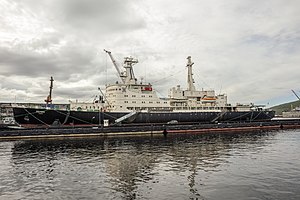Lenin (1957 icebreaker)
This article needs additional citations for verification. (November 2012) |
 Lenin docked at Murmansk
| |
| History | |
|---|---|
| Name | Lenin (Ленин) |
| Namesake | Vladimir Lenin |
| Builder | Baltic Shipbuilding, Leningrad USSR[1] |
| Launched | 1957[1] |
| Completed | 1959 |
| In service | 1959–1989 |
| Fate | Preserved as a museum ship |
| General characteristics | |
| Displacement | 16,000 tonnes [2] |
| Length | 134 m (440 ft)[1][2] |
| Beam | 27.6 m (91 ft)[1][2] |
| Height | 16.1 m (53 ft) |
| Draught | 10.5 m (34 ft)[1] |
| Installed power | list error: <br /> list (help) Three OK-150 nuclear reactors (3 × 90 MW) (until 1970) Two OK-900 nuclear reactors (2 × 171 MW) (since 1970) Four steam turbine generators |
| Propulsion | Nuclear-turbo-electric, three shafts[1] |
| Speed | 18 knots (33 km/h; 21 mph)[1] |
| Crew | 243 |
Lenin (Russian: Ленин) is a decommissioned Soviet nuclear-powered icebreaker. Launched in 1957, it was both the world's first nuclear-powered surface ship[2] and the first nuclear-powered civilian vessel. Lenin entered operation in 1959 and worked clearing sea routes for cargo ships along Russia's northern coast. From 1960 to 1965 the ship covered over 85,000 miles during the Arctic navigation season, of which almost 65,000 were through ice.[2] On April 10th 1974 the vessel was awarded the Order of Lenin. She was officially decommissioned in 1989.[1] She was subsequently converted to a museum ship and is now permanently based at Murmansk.
Propulsion
When launched in 1957, Lenin was powered by three OK-150 reactors. In its late-1960s configuration, at full capacity the ship used five to six pounds of uranium-235 per 100 days.[2]
In the later configuration (two nuclear reactors), the reactors provided steam for four steam turbines. These were connected to generators, which powered three sets of electric motors to drive the ship's three propellers.
Nuclear accidents
In February 1965, there was a loss-of-coolant accident. After being shut down for refueling, the coolant was removed from the number two reactor before the spent fuel had been removed. As a result, some of the fuel elements melted and deformed inside the reactor. This was discovered when the spent elements were being unloaded for storage and disposal. 124 fuel assemblies (about 60% of the total) were stuck in the reactor core. It was decided to remove the fuel, control grid, and control rods as a unit for disposal; they were placed in a special cask, solidified, stored for two years, and dumped in Tsivolki Bay (near the Novaya Zemlya archipelago) in 1967.
The second accident was a cooling system leak which occurred in 1967, shortly after refueling. Finding the leak required breaking through the concrete and metal biological shield with sledgehammers. Once the leak was found, it became apparent that the sledgehammer damage could not be repaired; subsequently, all three reactors were removed, and replaced by two OK-900 reactors. This was completed in early 1970.[3]
Details of these accidents were not widely available until after the fall of the Soviet Union.

Retirement
Lenin was decommissioned in 1989, because its hull had worn thin from ice friction. She was laid up at Atomflot, a base for nuclear icebreakers in Murmansk, and according to Pravda.ru, repair and conversion into a museum ship was completed in 2005.
References
- ^ a b c d e f g h Paine, Lincoln P (1997). Ships of the World. Houghton-Mifflin. p. 298. ISBN 0-395-71556-3. LCCN 97-12872.
- ^ a b c d e f "Soviet Life". Soviet Life. 2 (149): 57. February 1969.
- ^ "Nuclear icebreaker Lenin". Russian nuclear icebreaker fleet. www.bellona.org. Archived from the original on 2007-10-15. Retrieved 2013-03-07.
{{cite web}}: Unknown parameter|deadurl=ignored (|url-status=suggested) (help)
External links
- NKS Evaluation of Russian Marine Nuclear Reactors
- Bellona Foundation Article on Icebreaker Lenin
- Barbara Jancar-Webster (July 2001). "Red Atom: Russia's Nuclear Power Program from Stalin to Today by Paul R. Josephson (review)". Russian Review. 60 (3): 452–454. JSTOR 2679691. Critical article on Lenin Icebreaker
